Story & Storyboards 27 Feb 2007 08:05 am
Boards
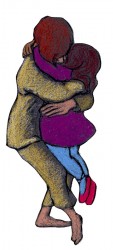 Mike Barrier continues the script vs. storyboard dialogue in some recent posts. I think this was recently prompted by some comments on Eddie Fitzegerald‘s site. Eddie sides with the storyboard lead, and all the comments on his blog, naturally, back him up. It’s John Krisfalusi‘s viewpoint, and it works for them in a somewhat hardened way.
Mike Barrier continues the script vs. storyboard dialogue in some recent posts. I think this was recently prompted by some comments on Eddie Fitzegerald‘s site. Eddie sides with the storyboard lead, and all the comments on his blog, naturally, back him up. It’s John Krisfalusi‘s viewpoint, and it works for them in a somewhat hardened way.
Mike Barrier is less dogmatic. His is the historian’s approach, and he talks primarily about ways others have worked. This approach to the argument appeals to me since I’m curious about what others have done in the past to make some of their great films.
However, in all honesty, I have to say that I’ve enjoyed reading both sides of the argument without any emotional involvment. None of it seems to match the way we’ve done films in my studio. I suspect this is true of all individual studios; methods are developed which work, and that’s the route followed. It also seems to vary with each and every film.
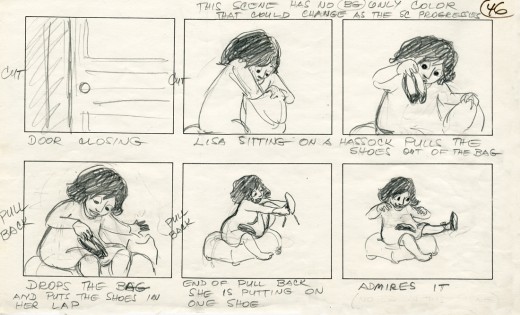 These are a few pages from my film The Red Shoes. This storyboard for a non-verbal section was done by Tissa David from a script by Maxine Fisher. The board changed the script. The LO’s changed the board, and Tissa’s animation of her own board & LO’s changed that.
These are a few pages from my film The Red Shoes. This storyboard for a non-verbal section was done by Tissa David from a script by Maxine Fisher. The board changed the script. The LO’s changed the board, and Tissa’s animation of her own board & LO’s changed that.
I love construction so feel that you have to work with a script. I’m not sure you can see a larger picture (for anything other than short films) with a storyboard only approach. However, after scripts are written, I generally ignore all descriptions of specific action after my initial reading. In doing the storyboard, I prefer to come up with my own movement to build around the dialogue. This is also a stage where I’ll eliminate a lot of dialogue (if I can).
Once the board is done, I go back to reread the script to see if the writer had anything more interesting than what I’ve come up with. Usually there is, and I’ll then plug this action into the board. We then do a rough animatic to see how it works and fix rough spots. Then it’s back to rewrite the script.
The film is always alive for me. If the actor improvises a better line, that’s the one. If we can make it better in Layout, we will. If we can change it to make the animation better, we will. If Coloring the piece offers a better idea, we’ll take it. Flexibility is the key. I make decisions and changes on the spot and live with them. Directing is dangerous.
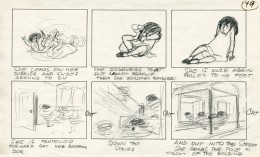
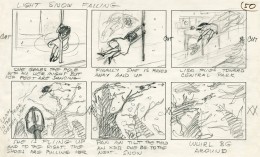 Tissa viewed an animatic we constructed to a tempo. She animated to the overall timing we gave her, but she changed the tempo and animated the four minute dance to a beat. Caleb Sampson had very little time, so he composed the music to the beat, and we made it work to Tissa’s final scene.
Tissa viewed an animatic we constructed to a tempo. She animated to the overall timing we gave her, but she changed the tempo and animated the four minute dance to a beat. Caleb Sampson had very little time, so he composed the music to the beat, and we made it work to Tissa’s final scene.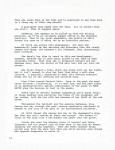
I like surprises. When an actor reads the line the way I’ve heard it in my head, it’s usually not the best reading. I want more personality. I tend to laugh at these surprises, and the actors become confused by my laughing during their dramatic readings.
This is true of every stage of production. I also love seeing unexpected happy bits in the animation. It’s all about the acting, the performance of the characters as channeled by the actors and animators.
(Script page – click to enlarge.)
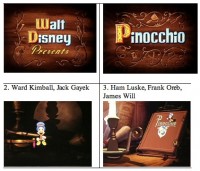 Mark Mayerson has begun a Mosaic culled from the information taken from the Drafts Hans Perk is posting on his site.
Mark Mayerson has begun a Mosaic culled from the information taken from the Drafts Hans Perk is posting on his site.
These Mosaics are a treasure from Mark; a quick visual reference to the film and the animators involved in the particular scenes. The amount of work he puts into them is enormous, and I couldn’t be more thankful. The same goes out to Hans for posting the Drafts.
With a work as monumental as Pinocchio, one can’t study it enough, and Mark’s Mosaics make it a little too easy for all of us.
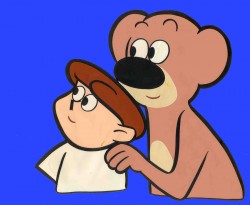 - Last year I wrote about Spunky & Tadpole. The post elicited some response. Most recently, Charles Brubaker wrote to tell me that an episode of the series has popped up on YouTube and can be reached here.
- Last year I wrote about Spunky & Tadpole. The post elicited some response. Most recently, Charles Brubaker wrote to tell me that an episode of the series has popped up on YouTube and can be reached here.
The episode almost looks as though it were shot off a tv screen, and that video was transferred to YouTube. Lots of color deterioration. However, it doesn’t look as bad as one might expect. Spunky and Tadpole wasn’t animated in Flash and looks better for it, despite the low quality transfer. (Click images to enlarge.)
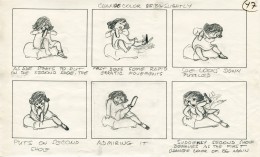
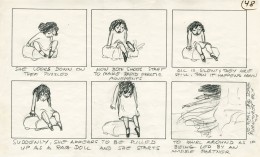

on 27 Feb 2007 at 12:40 pm 1.Stephen Worth said …
It isn’t John K’s viewpoint… It’s Walt Disney’s, stated many times over the years.
See ya
Steve
on 27 Feb 2007 at 12:43 pm 2.Stephen Worth said …
The other Walt said the same thing. If it’s dogmatism, John K is in good company!
See ya
Steve
on 27 Feb 2007 at 1:26 pm 3.Michael said …
Since a couple of the films had treatments and/or scripts done prior to boarding – Snow White, Lady & Tramp, 101 Dalmations among them – I’m not sure how locked into this idea Disney actually was. I’ve also never seen or heard an actual quote from him to state what he believed except pre-programed events done for TV where he is just trying to give some visual demonstration rather that express his true opinion. Lantz doesn’t ever talk about Features.
on 27 Feb 2007 at 3:23 pm 4.Anonymous said …
I think John K. is only purporting this viewpoint because scripts downplays his role as a ‘cartoonist’. I’ve talked with many who have worked with him in the past and the consensus is that John can draw really, really well but he CAN’T animate and doesn’t understand the principles of it. His only real experience is doing storyboards and key layouts.
So naturally John wouldn’t want something that takes away from his involvement with the cartoons.
on 27 Feb 2007 at 4:21 pm 5.Michael said …
An anonymous comment is not the best for such a comment. I don’t know John nor whether he animates, but I do have full confidence that that isn’t his motivation for wanting storyboards over scripts.
In fact, I actually think it’s a verbal or image kinda thing. Most animation people, I suspect, prefer and think they have more control over images.
on 01 Mar 2007 at 8:54 pm 6.Charles Brubaker said …
Michael,
Thanks for the shout out.
Just thought I point out that ANOTHER episode of “Spunky and Tadpole” is on YouTube
http://www.youtube.com/watch?v=AjqcUAKggFs